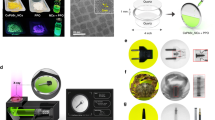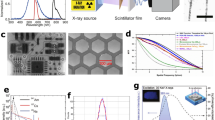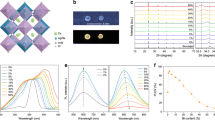Abstract
The urgency for affordable and reliable detectors for ionizing radiation in medical diagnostics, nuclear control and particle physics is generating growing demand for scintillator devices combining efficient scintillation, fast emission lifetime, high interaction probability with ionizing radiation and mitigated reabsorption losses in large-volume/high-density detectors. To date, the simultaneous achievement of all such features is still an open challenge. Here we realize this regime with poly(methyl methacrylate) nanocomposites embedding CsPbBr3 perovskite nanocrystals as sensitizers for a conjugated organic dye featuring a large Stokes shift and a fast emission lifetime in the red spectral region. Complete energy transfer from the nanocrystals to the dye under both X-rays and α-particle excitation results in highly stable radioluminescence with an efficiency comparable to that of commercial-grade inorganic and plastic scintillators; an ~3.4 ns emission lifetime, competitive with fast lanthanide scintillators; and reabsorption-free waveguiding for long optical distances.
This is a preview of subscription content, access via your institution
Access options
Access Nature and 54 other Nature Portfolio journals
Get Nature+, our best-value online-access subscription
$29.99 / 30 days
cancel any time
Subscribe to this journal
Receive 12 print issues and online access
$259.00 per year
only $21.58 per issue
Buy this article
- Purchase on Springer Link
- Instant access to full article PDF
Prices may be subject to local taxes which are calculated during checkout




Similar content being viewed by others
References
Dujardin, C. et al. Needs, trends, and advances in inorganic scintillators. IEEE Trans. Nucl. Sci. 65, 1977–1997 (2018).
Hajagos, T. J., Liu, C., Cherepy, N. J. & Pei, Q. High-Z sensitized plastic scintillators: a review. Adv. Mater. 30, 1706956 (2018).
Lecoq, P. Pushing the limits in time-of-flight PET imaging. IEEE Trans. Radiat. Plasma Med. Sci. 1, 473–485 (2017).
Turtos, R. M. et al. Ultrafast emission from colloidal nanocrystals under pulsed X-ray excitation. J. Instrum. 11, P10015–P10015 (2016).
Knoll, G. F. Radiation Detection and Measurement (John Wiley & Sons, 2010).
Rupert, B. L. et al. Bismuth-loaded plastic scintillators for gamma-ray spectroscopy. Europhys. Lett. 97, 22002 (2012).
Liu, C. et al. Transparent ultra-high-loading quantum dot/polymer nanocomposite monolith for gamma scintillation. ACS Nano 11, 6422–6430 (2017).
Lan, G. et al. Nanoscale metal–organic framework hierarchically combines high-Z components for multifarious radio-enhancement. J. Am. Chem. Soc. 141, 6859–6863 (2019).
Protesescu, L. et al. Nanocrystals of cesium lead halide perovskites (CsPbX3, X = Cl, Br, and I): novel optoelectronic materials showing bright emission with wide color gamut. Nano Lett. 15, 3692–3696 (2015).
Shamsi, J. et al. Metal halide perovskite nanocrystals: synthesis, post-synthesis modifications, and their optical properties. Chem. Rev. 119, 3296–3348 (2019).
Dirin, D. N. et al. Harnessing defect-tolerance at the nanoscale: highly luminescent lead halide perovskite nanocrystals in mesoporous silica matrixes. Nano Lett. 16, 5866–5874 (2016).
Kim, Y. C. et al. Printable organometallic perovskite enables large-area, low-dose X-ray imaging. Nature 550, 87–91 (2017).
Heo, J. H. et al. High-performance next-generation perovskite nanocrystal scintillator for nondestructive X-ray imaging. Adv. Mater. 30, 1801743 (2018).
Wei, H. & Huang, J. Halide lead perovskites for ionizing radiation detection. Nat. Commun. 10, 1066 (2019).
He, Y. et al. High spectral resolution of gamma-rays at room temperature by perovskite CsPbBr3 single crystals. Nat. Commun. 9, 1609 (2018).
Chen, Q. et al. All-inorganic perovskite nanocrystal scintillators. Nature 561, 88–93 (2018).
Zhang, Y. et al. Metal halide perovskite nanosheet for X-ray high-resolution scintillation imaging screens. ACS Nano 13, 2520–2525 (2019).
Wei, H. et al. Sensitive X-ray detectors made of methylammonium lead tribromide perovskite single crystals. Nat. Photonics 10, 333–339 (2016).
Wei, W. et al. Monolithic integration of hybrid perovskite single crystals with heterogenous substrate for highly sensitive X-ray imaging. Nat. Photonics 11, 315–321 (2017).
Yakunin, S. et al. Detection of gamma photons using solution-grown single crystals of hybrid lead halide perovskites. Nat. Photonics 10, 585–589 (2016).
Yakunin, S. et al. Detection of X-ray photons by solution-processed lead halide perovskites. Nat. Photonics 9, 444–449 (2015).
Nikl, M. & Yoshikawa, A. Recent R&D trends in inorganic single-crystal scintillator materials for radiation detection. Adv. Opt. Mater. 3, 463–481 (2015).
Akkerman, Q. A. et al. Strongly emissive perovskite nanocrystal inks for high-voltage solar cells. Nat. Energy 2, 16194 (2016).
Lorenzon, M. et al. Role of nonradiative defects and environmental oxygen on exciton recombination processes in CsPbBr3 perovskite nanocrystals. Nano Lett. 17, 3844–3853 (2017).
Rodà, C. et al. O2 as a molecular probe for nonradiative surface defects in CsPbBr3 perovskite nanostructures and single crystals. Nanoscale 11, 7613–7623 (2019).
Henschel, H., Kuhnhenn, J. & Weinand, U. Radiation hard optical fibers. In Proc. OFC/NFOEC Technical Digest. Optical Fiber Communication Conference, 2005 4–8 (IEEE, 2005).
Rainò, G. et al. Underestimated effect of a polymer matrix on the light emission of single CsPbBr3 nanocrystals. Nano Lett. 19, 3648–3653 (2019).
Bulin, A.-L. et al. Modelling energy deposition in nanoscintillators to predict the efficiency of the X-ray-induced photodynamic effect. Nanoscale 7, 5744–5751 (2015).
Moszynski, M. et al. Absolute light output of scintillators. IEEE Trans. Nucl. Sci. 44, 1052–1061 (1997).
Zhmurin, P. N. et al., Plastic scintillators with the improved radiation hardness level. In Proc. International Conference on Engineering of Scintillation Materials and Radiation Technologies (Eds Gektin, A. & Korzhik, M.) 125–145 (Springer, 2019).
Wolszczak, W., Krämer, K. W. & Dorenbos, P. CsBa2I5:Eu2+, Sm2+—the first high-energy resolution black scintillator for γ-ray spectroscopy. Phys. Status Solidi Rapid Res. Lett. 13, 1900158 (2019).
Dorenbos, P. (INVITED) The quest for high resolution γ-ray scintillators. Opt. Mater. X 1, 100021 (2019).
Rodnyi, P. A. Core–valence luminescence in scintillators. Radiat. Meas. 38, 343–352 (2004).
Visser, R., Dorenbos, P., Eijk, C. W. E. V. & Hartog, H. W. D. Energy transfer processes observed in the scintillation decay of BaF2:La. J. Phys. Condens. Matter 4, 8801–8812 (1992).
van Eijk, C. W. E. Cross-luminescence. J. Lumin. 60–61, 936–941 (1994).
Novotny, R. W. et al. High-quality lead tungstate crystals for PANDA produced at CRYTUR. IEEE Trans. Nucl. Sci. 65, 1998–2003 (2018).
Feiler, L., Langhals, H. & Polborn, K. Synthesis of perylene-3,4-dicarboximides—novel highly photostable fluorescent dyes. Liebigs Ann. 1995, 1229–1244 (1995).
Acknowledgements
We gratefully acknowledge financial support from the Italian Ministry of University and Research (MIUR) through the grant Dipartimenti di Eccellenza-2017 ‘Materials For Energy’, from the Istituto Nazionale di Fisica Nucleare (INFN) through the ESQUIRE project and from EU-H2020 through the EIT SPARK project (grant no. 16290). L.M. acknowledges funding from the programme for research and innovation Horizon 2020 (2014–2020) under the Marie Skłodowska-Curie Grant Agreement COMPASS no. 691185.
Author information
Authors and Affiliations
Contributions
M.F. and S.B. conceived this study. M.G., I.M. and L.M. synthesized and characterized the nanocrystals. L.B. and M.S. synthesized the dye. M.G. and F.C. produced the nanocomposites. M.G., E.F. and M.L.Z. performed the optical characterization and waveguiding experiments. I.V. performed the radioluminescence measurements under the supervision of M.F. and A.V.; M.B., C.G., C.B. and L.G. performed the scintillation and waveguiding measurements with α-particles. M.G. performed the Monte Carlo simulations. S.B. wrote the paper in consultation with all authors.
Corresponding authors
Ethics declarations
Competing interests
The authors declare no competing interests.
Additional information
Peer review information Nature Nanotechnology thanks Christophe Dujardin and the other, anonymous, reviewers for their contribution to the peer review of this work.
Publisher’s note Springer Nature remains neutral with regard to jurisdictional claims in published maps and institutional affiliations.
Extended data
Extended Data Fig. 1 Control nanocomposites with CsPbCl3 nanocrystals.
a. Optical absorption (dashed lines) and photoluminescence (solid lines) of CsPbCl3 NCs (blue lines) and 1 (red lines) in toluene under 385 nm excitation. b. Time decay traces of the photoluminescence of CsPbCl3 NCs in PMMA nanocomposites (2.0 wt%) in the absence (blue line) and in the presence of 0.155 wt% of 1 (purple line). c. Radioluminescence spectra of PMMA nanocomposites embedding 2.0 wt% of CsPbCl3 NCs (blue line), 0.155 wt% of 1 (red line) or a CsPbCl3:1 blend (2.0 wt% and 0.155 wt% respectively, purple line) under X-ray irradiation (30 kV, 20 mA).
Supplementary information
Supplementary Information
Supplementary discussion.
Source Data
Source Data Fig. 1
Data for panels in spreadsheets
Source Data Fig. 2
Data for panels in spreadsheets
Source Data Fig. 3
Data for panels in spreadsheets
Source Data Fig. 4
Data for panels in spreadsheets
Source Data Extended Data Fig. 1
Data for Extended Data Fig. 1
Rights and permissions
About this article
Cite this article
Gandini, M., Villa, I., Beretta, M. et al. Efficient, fast and reabsorption-free perovskite nanocrystal-based sensitized plastic scintillators. Nat. Nanotechnol. 15, 462–468 (2020). https://doi.org/10.1038/s41565-020-0683-8
Received:
Accepted:
Published:
Issue Date:
DOI: https://doi.org/10.1038/s41565-020-0683-8
This article is cited by
-
Efficient and ultrafast organic scintillators by hot exciton manipulation
Nature Photonics (2024)
-
Water-dispersible X-ray scintillators enabling coating and blending with polymer materials for multiple applications
Nature Communications (2024)
-
Brighter organic scintillators by hot exciton manipulation
Nature Photonics (2024)
-
Real-time single-proton counting with transmissive perovskite nanocrystal scintillators
Nature Materials (2024)
-
Enabling metallic behaviour in two-dimensional superlattice of semiconductor colloidal quantum dots
Nature Communications (2023)



